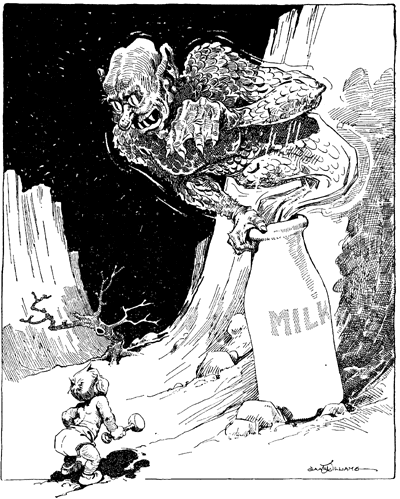by Haley Brinker, IMHM graduate intern from the Public History Department at IUPUI
 In the Bacteriology Laboratory of the Indiana Medical History Museum, you’ll find a photograph of Dr. John Hurty, hard at work at his desk. Next to this photograph, you’ll discover a large poster depicting a goblinesque typhoid germ, beckoning and inviting you to meet it at the town pump. This poster, commissioned by the ever public health-conscious Dr. Hurty and created by cartoonist Garr Williams, is a reflection of the very serious typhoid problem threatening the health of Indiana’s citizens at that time. In order to combat this problem, Dr. Hurty recognized that commissioning memorable posters that left little room for confusion of their messages would make it easier for the public at large to understand the public health issues facing them.
In the Bacteriology Laboratory of the Indiana Medical History Museum, you’ll find a photograph of Dr. John Hurty, hard at work at his desk. Next to this photograph, you’ll discover a large poster depicting a goblinesque typhoid germ, beckoning and inviting you to meet it at the town pump. This poster, commissioned by the ever public health-conscious Dr. Hurty and created by cartoonist Garr Williams, is a reflection of the very serious typhoid problem threatening the health of Indiana’s citizens at that time. In order to combat this problem, Dr. Hurty recognized that commissioning memorable posters that left little room for confusion of their messages would make it easier for the public at large to understand the public health issues facing them.
Another of these posters (above) depicts a Creature from the Black Lagoon lookalike, rising from a bottle of milk, while a helpless, diapered child looks on, his rattle his only defense. Looking at this poster today, one can’t help but wonder what on earth could be so deadly about drinking something so seemingly harmless as milk.
To put it simply, milk, prior to pasteurization and federal regulation, was absolutely disgusting. One analysis showed that a sample of milk in New Jersey had so many bacterial colonies that the scientists just stopped counting. Dairymen at the time often used cost-saving and morally questionable tricks in order to ensure that they could milk (sorry) the most profit out of their product. One such trick was thinning the milk with water. In one case, a family reported that their milk appeared to be “wriggling.” Upon investigation, it was discovered that the milkman had used “stagnant” water nearby, which was apparently full of tiny, insect eggs that grew into tiny, insect larva, causing the “wriggling” the family had noticed. Aside from being a scene out of one of your elementary school lunchtime nightmares, it further illustrated the need to regulate the industry. After the thinning process, the milk would sometimes be discolored. In order to solve this problem, the dairymen simply added things like chalk or plaster to turn it back to the crisp, white color their customers expected. Then, it gets nauseating. In order to make doctored dairy look “richer” and more cream colored, a puree of calf brains would sometimes be added to the mixture.
Samples of milk tested during that time often had “sticks, hairs, insects, blood, and pus,” but it gets worse. There was also a lot of manure present. There was so much manure in Indianapolis’s milk in 1900 that “it was estimated that the citizens of Indianapolis consumed more than 2000 pounds of manure in a given year.” How could the powers that be possibly fight against all the rampant bacteria and the illness it caused? With formaldehyde of course! What better way to cure society’s ills than with embalming fluid in the food we eat and the milk we drink. Even our illustrious Dr. Hurty was on board at the beginning. However, he soon realized that it was doing more harm than good. Often, formaldehyde-related outbreaks of illness would occur, and could even be deadly, especially in children. In 1901, Hurty stated that over 400 children had died from milk tainted with either the chemical, dirt, or bacteria.
When the federal government finally got around to passing the Federal Pure Foods and Drugs Act in 1906, the practice of putting formaldehyde in food was finally banned. While government-mandated pasteurization of dairy was still a long way off, the tireless efforts of Dr. Hurty to remove formaldehyde from milk helped pave the way for legal change to better protect the public from those that would profit at the expense of their health.
TO SEE MORE OF HURTY'S COMMISSIONED CARTOONS AND LEARN MORE ABOUT INDIANA's 1899 PURE FOOD & DRUGS ACT, VISIT THE ONLINE EXHIBIT "FOOD FIGHT!"
References:
Blum, D. (2018). The 19th-century fight against bacteria-ridden milk preserved with embalming fluid. Retrieved from https://www.smithsonianmag.com/science-nature/19th-century-fight-bacteria-ridden-milk-embalming-fluid-180970473/#:~:text=In%20late%201900%2C%20Hurty's%20health,was%20%E2%80%9Cwriggling.%E2%80%9D%20It%20turnedAugust 6, 2020.
Thurman B. Rice, MD. “Dr. Thaddeus M. Stevens- Pioneer in Public Health [Chapter XIV].” In The Hoosier Health Officer: A Biography of Dr. John N. Hurty, 57–60, n.d.